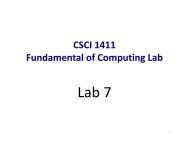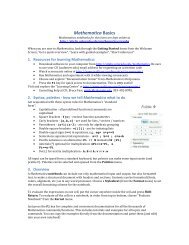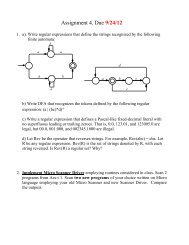[PDF] The Thickness and Chromatic Number of r - Gammeter.com
[PDF] The Thickness and Chromatic Number of r - Gammeter.com
[PDF] The Thickness and Chromatic Number of r - Gammeter.com
Create successful ePaper yourself
Turn your PDF publications into a flip-book with our unique Google optimized e-Paper software.
produce r − 1 other graphs, each <strong>of</strong> which is isomorphic to L1 <strong>and</strong> whose union with<br />
L1 is exactly I[r].<br />
To this end, recall that in the pro<strong>of</strong> <strong>of</strong> Lemma 1, a linearly ordered set <strong>of</strong> vertices<br />
v1, v2r, . . . , vr, vr+1 represents a path <strong>of</strong> length 2r − 1 called P1. We produced a set <strong>of</strong><br />
r−1 more paths <strong>of</strong> length 2r−1, called Pi, i = 1, . . . , r−1 by effecting a permutation<br />
on the indices <strong>of</strong> the vertices in P1. We showed that, by construction, the paths are<br />
pairwise edge disjoint. In particular, path Pi is obtained from P1 by adding i − 1 to<br />
the index <strong>of</strong> each vertex in P1 <strong>and</strong> reducing the results modulo 2r. For the problem<br />
at h<strong>and</strong>, we similarly obtain planar layer Li from L1. That is, after each edge <strong>of</strong><br />
the given matching <strong>of</strong> I has been subdivided, new edges added, <strong>and</strong> vertices suitably<br />
labeled to yield L1, we define Li to be the graph obtained by adding i − 1 (mod 2r)<br />
to the index <strong>of</strong> each vertex <strong>of</strong> L1. We do this for i = 2, . . . , r. Since Li is isomorphic<br />
to L1, each Li is planar for i = 1, . . . , r. Let I = L1 ∪ L2 ∪ · · · ∪ Lr. It follows from<br />
Lemma 1 that E(Li) ∩ E(Lj) = ∅ whenever i �= j.<br />
For convenience, given any vertex x in I we let x[r] denote the Kr in I[r] associated<br />
with x. We will also need to keep track <strong>of</strong> which vertices <strong>of</strong> Li are in the positions<br />
<strong>of</strong> the original vertices in I. Thus a vertex <strong>of</strong> Li will be said to be in position y if it<br />
occupies the position y occupies in I. By Lemma 1, given a vertex x in I, for each<br />
vertex v ∈ V (x[r]), the label v will occupy position x in exactly one <strong>of</strong> the graphs Li<br />
for i = 1, . . . , r.<br />
We claim that I = I[r]. To prove the claim, we first take x to be an arbitrary<br />
vertex in I <strong>and</strong> consider the edges that must be incident with x[r]. See Figure 4<br />
for a reminder <strong>of</strong> how x relates to its neighbors after subdividing edges <strong>of</strong> the given<br />
matching. Since the choice <strong>of</strong> x is arbitrary, it suffices to show that all <strong>of</strong> the edges<br />
in the join <strong>of</strong> x[r] with a[r], b[r], c[r], d[r], <strong>and</strong> e[r] are contained in I.<br />
<strong>The</strong> join <strong>of</strong> x[r] with a[r] induces a K2r by definition. By our construction <strong>and</strong><br />
Lemma 1, since xa is an edge <strong>of</strong> the chosen perfect matching, the join <strong>of</strong> x[r] with<br />
a[r] is contained in I. Further, the join <strong>of</strong> x[r] with b[r] is contained in I because<br />
each vertex in b[r] appears in position b in exactly one Li by Lemma 1, <strong>and</strong> the<br />
vertex in position b is adjacent to all vertices in x[r]. <strong>The</strong> same argument applies to<br />
the join <strong>of</strong> x[r] with e[r]. Finally, the same argument applies again to the position x:<br />
each vertex in x[r] appears exactly once in position x, <strong>and</strong> a vertex in position x is<br />
adjacent to all elements <strong>of</strong> c[r] ∪ d[r]. Thus far we have shown that E(I[r]) ⊂ E(I).<br />
Since Θ(I) ≤ r, the same is true I[r]. That is, Θ(I[r]) ≤ r.<br />
11


![[PDF] The Thickness and Chromatic Number of r - Gammeter.com](https://img.yumpu.com/3978766/11/500x640/pdf-the-thickness-and-chromatic-number-of-r-gammetercom.jpg)





